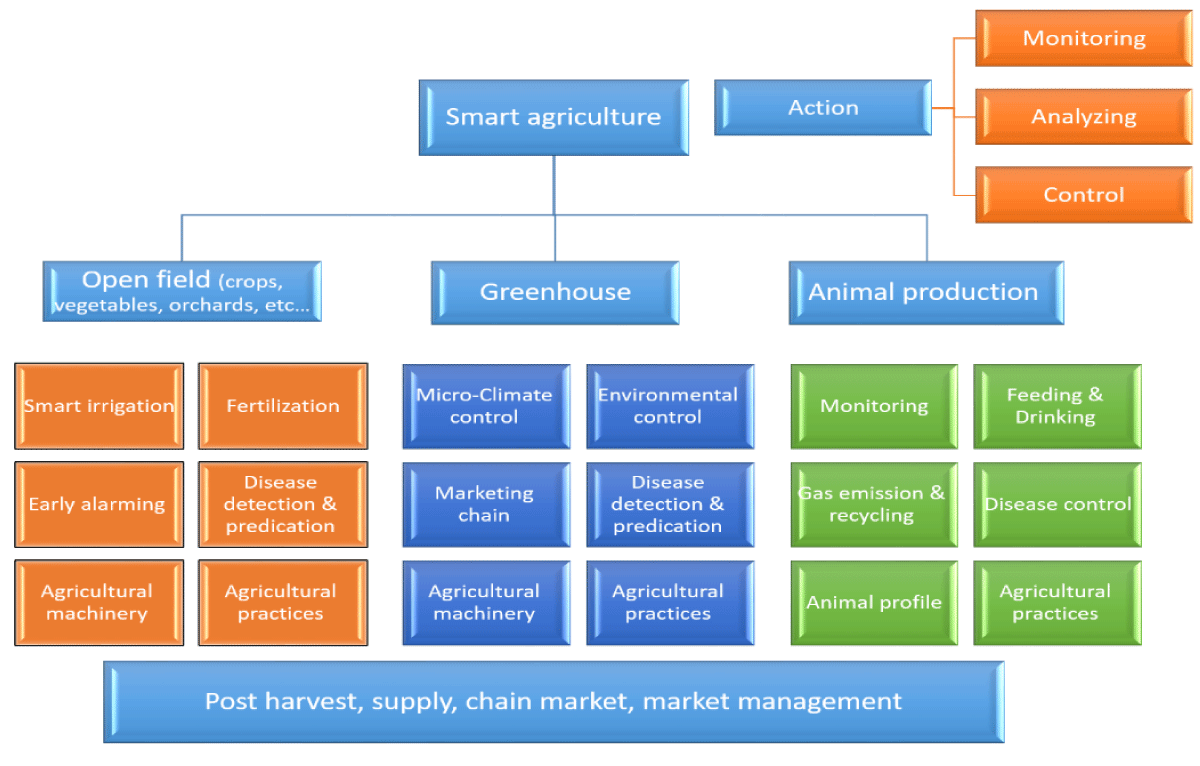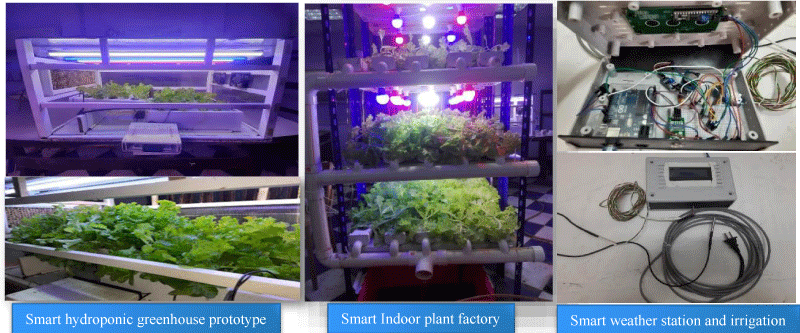More Information
Submitted: August 11, 2022 | Approved: December 02, 2022 | Published: December 05, 2022
How to cite this article: Abul-Soud M, The smart agriculture applications (current and future). Ann Civil Environ Eng. 2022; 6: 071-073.
DOI: 10.29328/journal.acee.1001045
Copyright License: © 2022 Abul-Soud M. This is an open access article distributed under the Creative Commons Attribution License, which permits unrestricted use, distribution, and reproduction in any medium, provided the original work is properly cited.
Keywords: Smart; Irrigation; Weather station; Soilless culture; Plant factory; IoT
The smart agriculture applications (current and future)
Mohamed Abul-Soud*
Central Laboratory for Agricultural Climate, Agricultural Research Center, Giza- Egypt
*Address for Correspondence: Mohamed Abul-Soud, Central Laboratory for Agricultural Climate, Agricultural Research Center, Giza- Egypt, Email: [email protected]
Smart agriculture applications (monitoring, sensing, automation and control) of micro-climate and environmental conditions for different agriculture production sectors and scales, decision-makers and researchers need to take it into consideration to strengthen the efforts of mitigation and adaption of climate change impacts as well as maximize the natural resources use efficiencies and food production. Motivate the farmers to implement smart agriculture applications, especially in developed and poor countries, strong cooperation for technology transfer and build up the technology infrastructure of information and communication (ICT) plus the internet of things (IoT).
Smart agriculture applications varied regarding the agriculture systems, practices, operations and processes. The next Figure (Figure 1) illustrates the different application categories of smart agriculture in general. Each category has many applications targeted to increase the profit yield, optimize the natural resources use efficiency, minimize the climate change impacts and conserve the environment.
Figure 1:
Smart agriculture is concerned with advanced technology in growing food sustainably with rationalizing the use of natural resources, especially water. The information management and analysis systems implement to make the best possible production decisions, at the lowest costs, as well as the automation of agricultural practices such as irrigation, pest control, soil control and crop control (USAID 2016). The most interesting smart agriculture application could be summarized by Madushanki, et al. 2019 and Kanumuri [1] as follows:
1. Smart agriculture weather station based on IoT,
2. Design, control, and management of irrigation system and fertigation program
3. Smart management of different agricultural systems
4. Monitoring the growth stages of crops and animals,
5. The applications of drones and robots in monitoring, control, alarm and process,
6. Integrated pest management,
7. Accomplish arduous agricultural work through automated mechanization,
8. Smart harvesting process management,
9. Smart Market chain management.
In a scientific survey done by the author team for pioneer farmers under Egyptian conditions, more than 300 farmers presented their concerns on smart agriculture and their needs that matched above mentioned as follows:
1. Smart agriculture weather station for early warning against extreme weather events (efficient, low cost, friendly use and operation and etc.),
2. Smart irrigation system and management based on the applications of weather data, or directly via soil moisture sensors or both (smart automation control for irrigation system On/Off, time, monitoring the soil moisture and alarming for irrigation system problems),
3. Estimate the irrigation requirement based on IoT,
4. Monitoring system for micro-climate and environmental condition of open field and greenhouse crops as well as for different animal husbandry and pasture,
5. Automated control systems for micro-climate and environmental condition of the greenhouse, soilless culture systems, aquaculture, aquaponic and different scales of animal husbandry,
6. Smart Integrated pest management (to identify the pest and symptoms and address the right management approach and application),
7. Administrate the fertigation program (estimate the fertilizer requirements, monitor the EC, pH, the injection process, the fertigation efficiency),
8. Monitoring the growth stages and healthy status of crops and animals,
9. Accomplish arduous agricultural work,
10. Harvesting process (Recommended the harvesting date, time, method, and post-treatment),
11. Market chain (management of packing, transportation, storehouse, e-trading, e-commerce),
12. The applications of drones and robots in monitoring, control, alarm and process, (integrated application of remote agriculture mechanization, remote sensing via drones and robots, computer vision, machine learning and artificial intelligence) are absent completely not just for ordinary farmers but also for researchers, private sectors and decision-makers.
Detecting micro-climate (Air temperature, relative humidity, light intensity, carbon dioxide (CO2), wind speed, etc...) and the environmental conditions (soil moisture, substrate and nutrient solution temperature, EC, pH, dissolved oxygen index (DOI), water level, etc...) through different sensors as well as smart automation control (developed borders (microcontroller and microprocessor) and actuators) integrated with the internet of things (IoT) provides the right decision, to mitigate climate change impacts and extreme weather events and to avoid the human mistakes on agriculture systems and production. IoT allows for machine-to-machine interaction and controlling the soilless culture and aquaponic systems autonomously and intelligently employing deep neural networks [2-12].
The author has different practical contributions to smart agriculture applications such as the following:
− The smart hydroponic greenhouse prototype established included two systems of hydroponic culture (Nutrient Film Technique (NFT) and Deep Flow Technique (DFT)). The greenhouse prototype was designed with artificial-grown light and a cooling pad system with a polycarbonate sheet cover. Smart monitoring and control systems based on Arduino Mega 2560 are programmed via the Arduino IDE program. Different sensors and actuators were wired to sense and monitor the micro-climate measurements on the LCD screen (DHT 22 (temperature and RH %), TSL 2561 (light intensity)) and environmental conditions (TDS sensor, pH kit, float switch (tank level) and waterproof temperature (solution temperature)) plus 4 channel relay module to implement smart automation of agricultural operations (cooling, ventilation, pumping, air supply, alarm and solution heating). Based on the Internet of Things (IoT) via Node MCU esp 8266 is programmed to transmit the data every 30 min. via Wi-Fi web google platform (Firebase) for presenting the real-time records and hosting the data. The smart hydroponic greenhouse pilot illustrated good performance in monitoring the micro-climate and environmental conditions. Agricultural operations control worked according to the programming of Arduino Mega with high efficiency. Node MCU esp 8266 transmits the collected data to the internet.
− The smart plant factory was designed and established based on a metal frame (90 x 120 x 200 cm) in 3 layers (30 lettuce plant/layers). The NFT technique was used in producing lettuce under different artificial light levels. The artificial grown light differed in intensity (81 watts = 6800 Lux, 108 watts = 9180 Lux and 162 watts = 13600 Lux) and type of LED lamps (Pulp and tube). The monitoring and smart control systems were established based on Arduino Mega 2560 as a smart hydroponic greenhouse prototype but with control for EC and pH of the nutrient solution plus a Camera to present visual monitoring. The system is under development regarding unsatisfying results of lettuce yield quality.
− Smart weather stations with smart irrigation manage-ment were developed for sensing and monitoring micro-climate conditions (air temperature, RH %, light intensity and soil temperature) as well as detecting and controlling soil moisture level. A resistive Soil moisture sensor was developed to avoid the low efficiency with a high cost of the available types in the market.
− Identifying tomato healthy state through optimized deep learning algorithms for tomato leaf disease and computer vision. The models were deployed on a Raspberry Pi 4 in order to build an Internet of Things device capable of tomato leaf disease detection (Figure 2).
Figure 2:
Let’s agree, what’s innovation today, it’s traditional tomorrow. Innovative smart agriculture technologies still have a lot of potential for all agriculture production sectors that face a lot of climate change risks, to match the food security needs and maximize the natural resources use efficiencies.
- Madushanki A. Raneesha A, Halgamuge MN, Surangi Wirasagoda WAH, Syed A. Adoption of the Internet of Things (IoT) in Agriculture and Smart Farming towards Urban Greening: A Review. International Journal of Advanced Computer Science and Applications(IJACSA). 2019;10 (4): 11-28.
- Karamanis G, Drosos C,Papoutsidakis M, Tseles D. Implementation of an Automated System for Controlling and Monitoring a Hydroponic Greenhouse International Journal of Engineering Science Invention (IJESI). 2018.; 7(10): 27-35.
- Fiorenza CEl, Sharma S, Ranjan S, Shashank. Smart e-agriculture monitoring based on Arduino using IoT. Ijsdr, 2018;3(10)
- Mehra M, Saxena S, Sankaranarayanan S, Tom RJ, Veeramanikandan M. 2018. IoT-based hydroponics system using deep neural networks. Computers and Electronics in Agriculture. 2018;155:473-486
- Alipio MI, AEMD C, Doria JDA, Fruto RMS. On the design of nutrient film technique hydroponics farm for smart agriculture. Journal of Engineering in Agriculture, Environment and Food. 2019;12:315-324
- Li N, Xiao Y, Shen L, Xu Z, Li B, Yin C. Smart Agriculture with an Automated IoT-Based Greenhouse System for Local Communities. Advances in Internet of Things. 2019; 9:15-31.
- Amy L, Rico J. Automated pH Monitoring and Controlling System for Hydroponics under Greenhouse Conditions. Journal of Engineering and Applied Sciences. 2020; 15 (2): 523-528.
- Siddiq A, Tariq MO, Zehra A, Malik S. ACHPA: A sensor-based system for automatic environmental control in hydroponics. Food Sci. Technol, Campinas. 2020; 40(3): 671-680.
- Abul-Soud MA, Emam MSA. Smart indoor plant factory based on soilless culture and IoT. 2022.
- Abul-Soud MA, Emam MSA, Mohammed ShM. Smart hydroponic greenhouse (Sensing, monitoring, and control) prototype based on Arduino and IoT. IJPSS. 2021; 33(4): 63-77.
- FAO. Climate-smart agriculture case studies, Projects from around the world. Rome. Italy. 2021.
- Tarek H, Aly HH, Eisa S, Abul-Soud M. Using Deep Neural Networks and Computer Vision to Identify Tomato Leaf Disease. Electronics, Version September. 2021; 1-19.

